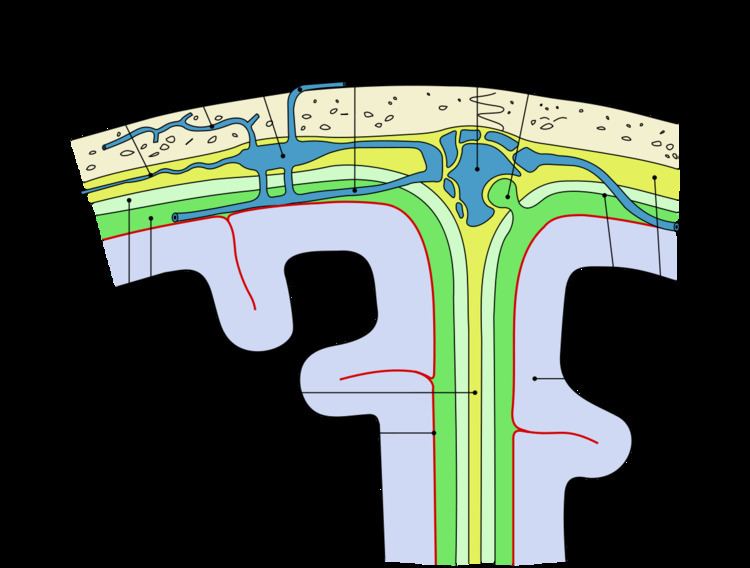NeuroNames ancil-561 TA A14.1.01.201 | MeSH A08.186.566.166 Dorlands/Elsevier a_56/12149123 FMA 9591 | |
 | ||
The arachnoid mater is one of the three meninges, the protective membranes that cover the brain and spinal cord. The arachnoid mater is a derivative of the Neural crest mesectoderm in the embryo.
Contents
Structure
It is interposed between the two other meninges, the more superficial and much thicker dura mater and the deeper pia mater, from which it is separated by the subarachnoid space. The delicate arachnoid layer is attached to the inside of the dura and surrounds the brain and spinal cord. It does not line the brain down into its sulci (folds), as does the pia mater, with the exception of the longitudinal fissure, which divides the left and right cerebral hemispheres. Cerebrospinal fluid (CSF) flows under the arachnoid in the subarachnoid space. The arachnoid mater makes arachnoid villi, small protrusions through the dura mater into the venous sinuses of the brain, which allow CSF to exit the subarachnoid space and enter the blood stream.
The arachnoid mater and dura mater are very close together throughout the cranium all the way to S2, where the two layers fuse into one layer and terminate. Sandwiched between the dura and arachnoid maters lie some veins that connect the brain's venous system with the venous system in the dura mater.
The arachnoid mater covering the brain is referred to as the "arachnoidea encephali," and the portion covering the spinal cord as the "arachnoidea spinalis." The arachnoid and pia mater are sometimes considered as a single structure, the leptomeninx, or the plural version, leptomeninges. ("Lepto"- from the Greek root meaning "thin"). Similarly, the dura in this situation is called the pachymeninx.
There are two subdivisions of arachnoid mater surrounding the subarachnoid space, the dorsal layer and the ventral layer. The dorsal layer covers internal cerebral veins and fixes them to the surrounding tela choroidea. The ventral layer of arachnoid membrane, on the other hand, is a direct anterior extension of this arachnoid envelope that the dorsal layer forms over the pineal region.
Function
CSF circulates in the subarachnoid space (between arachnoid and pia mater). Cerebrospinal fluid is produced by the choroid plexus (inside the ventricles of the brain, which are in direct communication with the subarachnoid space so the CSF can flow freely through the nervous system). Cerebrospinal fluid is a transparent, colourless fluid and it is produced at about 500 ml/day. Its electrolyte levels, glucose levels, and pH are very similar to those in plasma, but the presence of blood in cerebrospinal fluid is always abnormal.
Etymology
The arachnoid mater is named after the Greek word "Arachne" ("spider"), the suffix "-oid" ("in the image of"), and the Latin word "mater"("mother"), because of the fine spider web-like appearance of the delicate fibres of the arachnoid which extend down through the subarachnoid space and attach to the pia mater.
